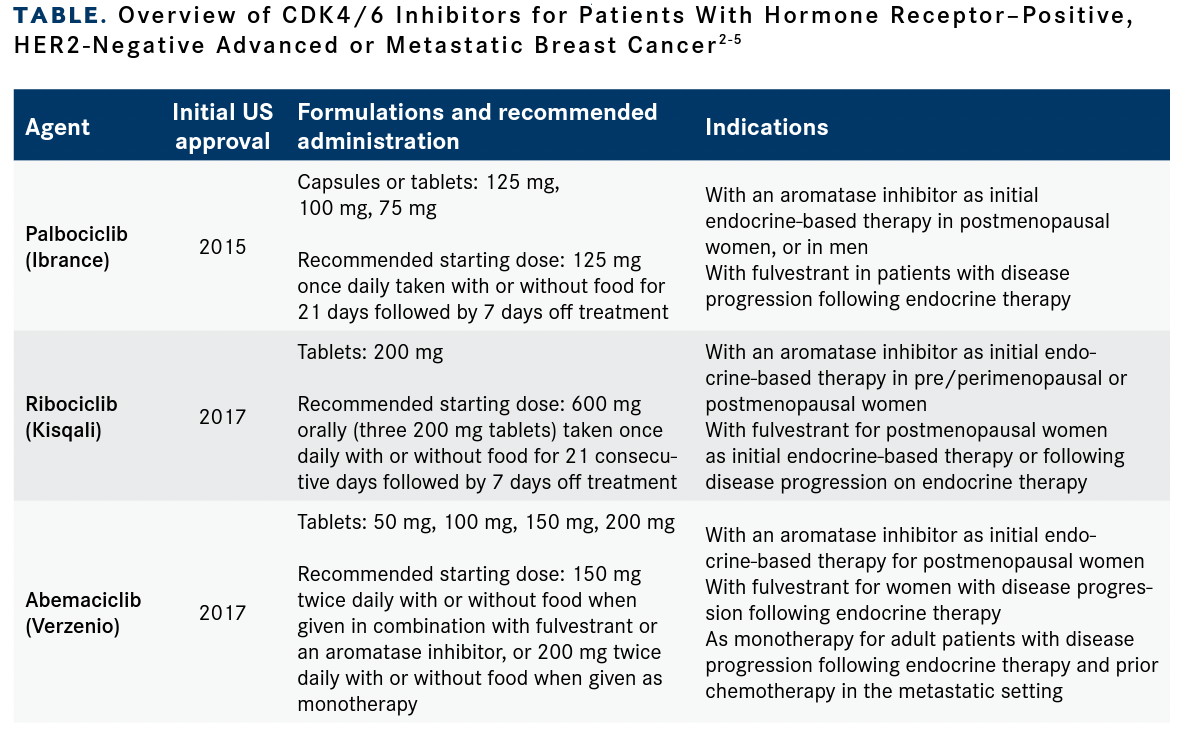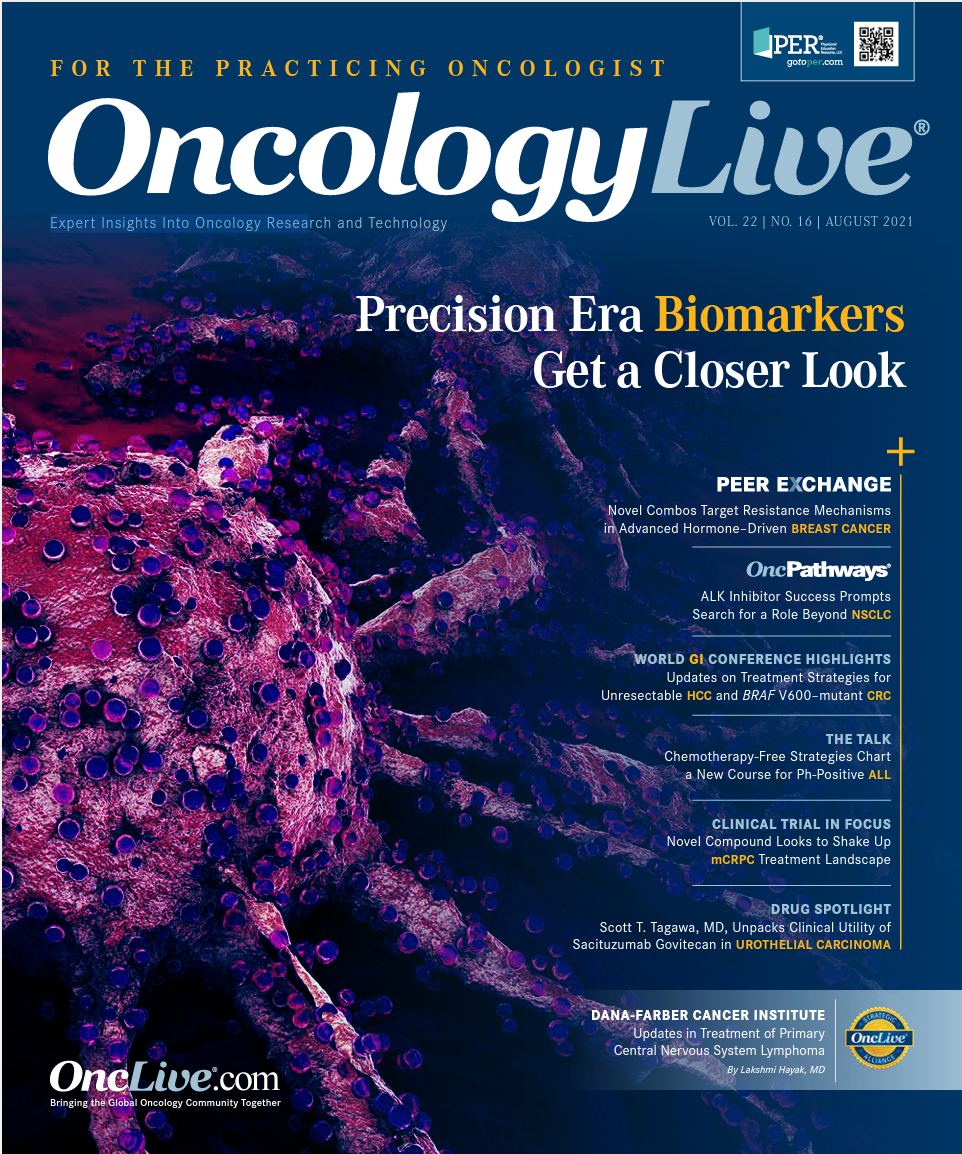Novel Combos Target Resistance Mechanisms in Advanced Hormone–Driven Breast Cancer
Acquired resistance to endocrine therapy has presented challenges for patients with hormone receptor–positive breast cancer.
Dejan Juric, MD

Acquired resistance to endocrine therapy has presented challenges for patients with hormone receptor–positive breast cancer. Historically, improvements in both survival and quality-of-life outcomes have made endocrine ther-apy the backbone of treatment for this patient population. However, up to 40% of tumors initially responsive to endocrine therapy develop resis-tance to the treatment.1 Investigators have turned their attention to iden-tifying tactics to circumvent mechanisms of resistance. Two of the most prominent avenues have been the investigations of combination therapies leveraging CDK4/6 inhibitors and PI3K inhibitors.
During a recent OncLive Peer Exchange®, a panel of breast cancer experts discussed the latest data for CDK4/6 inhibitors and PI3K inhibitors in patients with hormone receptor–positive advanced breast cancer, and they shared their experience using these agents in their practices. “We need to hit the cancer hard where it hurts and not allow for the disease burden to increase, the number of cells to increase, or the number of resistance mechanisms to increase,” Dejan Juric, MD, said.
CDK4/6 Inhibitors: Latest OS Data
Three CDK4/6 inhibitors have been approved by the FDA for patients with hormone receptor–positive, HER2-negative advanced or metastatic breast cancer (TABLE2-4). Initial approvals were based on improvements in progression-free survival (PFS). However, data from multiple clinical trials have since shown an overall survival (OS) benefit with these agents.
TABLE. Overview of CDK4/6 Inhibitors for Patients With Hormone Receptor–Positive, HER2-Negative Advanced or Metastatic Breast Cancer2-5

In the second- and subsequent-line settings, the MONARCH-2 trial (NCT02107703) showed a clinically mean-ingful median OS benefit of 9.4 months with the addition of abemaciclib (Verzenio) to fulvestrant in women with hormone receptor–positive, HER2-negative advanced breast cancer that had progressed on endocrine therapy, regardless of their menopausal status.5
In the PALOMA-3 trial (NCT01942135), after a median follow-up of 44.8 months, the addition of palbociclib (Ibrance) to fulvestrant led to a 6.9-month OS benefit in patients with hormone receptor–positive, HER2-negative advanced breast cancer that had previously responded to endocrine therapy. Specifically, the reported median OS was 34.9 months in the palbociclib arm vs 28.0 months in the placebo arm.6 Further, after a median follow-up of 73.3 months, this benefit was maintained with a median OS of 34.8 months in the palbociclib arm and 28.0 months in the placebo arm (P < .0221).7
“[PALOMA-3] is a unique trial in that it included patients who had received about a third of prior chemotherapy and multiple lines of treatment, [and] the control arm didn’t do as well,” said Hope S. Rugo, MD, FASCO, a 2020 Giants of Cancer Care® award winner in the education category. “This suggests that the group who didn’t get chemotherapy, who presumably are more sensitive to endocrine therapy overall, had a survival difference in line with the other trials.”
Hope S. Rugo, MD, FASCO

Similarly, an OS benefit has also been observed with ribociclib (Kisqali). In the MONALEESA-3 trial (NCT02422615), which included postmenopausal women treated in both the first-and second-line settings with ribociclib plus fulvestrant or placebo plus fulvestrant, treatment benefit was seen in both ribociclib-treated populations.8 “[Investigators have] showed that in the second-line setting, the absolute difference in OS is highly significant, and there’s a 6-month difference. They still haven’t reached the median in the first-line setting, but the hazard ratio is 0.64, showing a benef it in the first-line setting in this group of postmenopausal patients,” Rugo said.
MONALEESA-7 (NCT02278120) was the first clinical trial to show a statistically significant OS benefit with a CDK4/6 inhibitor plus endocrine therapy in the firstline setting for patients with advanced breast cancer, Rugo said. The trial randomly assigned pre- or perimenopausal patients with hormone receptor–positive, HER2 negative advanced breast cancer 1:1 to receive ribociclib or placebo plus goserelin with either a nonsteroidal aromatase inhibitor (ie, letrozole or anastrozole) or tamoxifen.9
After a median follow-up of 53.5 months (minimum, 46.9 months), the median OS was 58.7 months with ribociclib plus endocrine therapy vs 48.0 months with placebo plus endocrine therapy (HR, 0.76; 95% CI, 0.61-0.96). A similar survival benefit was observed with ribociclib in the patients who received a nonsteroidal aromatase inhibitor, with a median OS of 58.7 months vs 47.7 months (HR, 0.80; 95% CI, 0.62-1.04). “The median OS was increased by [approximately] 11 months…this [trial included] almost 700 patients, and the data [were] practice-changing,” Rugo said.
Based on the data from these clinical trials and other trials that have shown significant benefit across end points—including time to first chemotherapy, chemotherapy-free survival, and PFS—the panelists noted that it is difficult to find a patient with hormone receptorpositive, HER2-negative breast cancer who should not receive a CDK4/6 inhibitor, especially in the first-line setting. “Later use of these therapies can be problematic,” Juric said. “Some patients may never get that treatment if something catastrophic happens in the first-line setting.” He explained that although these patients historically had an OS of approximately 2 years, data from newer studies that added CDK4/6 inhibitors have reported median OS of 4 or 5 years, making them an invaluable treatment option.
Selecting Between CDK4/6 Inhibitors
Investigators have not produced comparative data between palbociclib, ribociclib, and abemaciclib. Moderator Andrew D. Seidman, MD, asked the panelists how they “parse this embarrassment of riches” to decide which agent to use for their patients. The panelists cited a variety of factors when deciding, such as differences in eligibility criteria between clinical trials, toxicity profiles, drug targets, access and finance issues, and ease of dose reduction.
Andrew D. Seidman, MD

Juric said he pays particular attention to the population in which the primary data were generated. “If I have a premenopausal patient, I’m prescribing ribociclib. If I’m have a patient who has primary endocrine-resistant breast cancer, a high visceral disease burden where ER and [progesterone receptor] status are questioned in terms of their amount or positivity, and I’m not worried about [gastrointestinal] toxicity, then I really like abemaciclib,” he said.
Although these agents are similar and are all classified as CDK4/6 inhibitors, Juric said they are different drugs with different chemical structures and different target inhibition profiles. “Breast cancers tend to be really dependent primarily on CDK4, at least initially, and palbociclib is equipotent there, [whereas] the other 2 drugs preferentially hit CDK4. That may not necessarily come into play initially in the first readouts of these trials, but they may play a role as you start looking at a longer effect or more distant clinical end points,” he said.
Nicholas P. McAndrew, MD, MSCE, noted that looking to eligibility criteria across the studies may aid in treatment decisions, citing differences in survival data that exist between the missed prespecified end points of OS for palbociclib compared with real world evidence. “Subsequent analysis has been conducted, as well as exploratory and other interesting OS analyses of palbociclib examined real-world evidence for instance, those from the Flatiron database,” McAndrew said. “These data suggest that there is potentially OS benefit with palbociclib and it makes one more inclined to really question whether these differences in survival that we are seeing [are] primarily because of study design and inclusion of patients who just weren’t included in the other trials.”
Nicholas P. McAndrew, MD, MSCE

Aditya Bardia, MD, MPH, discussed the toxicity profiles of the agents and ease of dosing, noting “ribociclib and palbociclib tend to cause more myelosuppression, and abemaciclib tends to cause more diarrhea.” He explained that when dose reduction becomes necessary with these agents, it is more challenging with palbociclib because “you must change pills from 125 mg to 100 mg, whereas with ribociclib, you start with 3 tablets and then reduce to 2 tablets.” Subsequently, palbociclib requires “another call to the insurance company and getting the new supply of 100 pills,” he said.
Aditya Bardia, MD, MPH

Considering PIK3Cα Mutations
Activating mutations in PIK3Cα and resultant activation of the protein can be found in approximately 40% of patients with ER-positive metastatic breast cancer, Juric said, emphasizing that PIK3Cα should be looked for upon obtaining the first diagnostic specimen. “PIK3Cα is an important regulator of cell signaling, mediating growth signals that come from the membrane of the cell and go into the cell cycle machinery,” he added.
Although activation of the PI3K pathway via PIK3Cα mutations is associated with poor prognosis in patients with hormone receptor– positive, HER2-negative advanced breast cancers, the SOLAR-1 trial (NCT02437318) showed a 7.9-month numeric improvement in median OS in these patients when the PI3K inhibitor alpelisib (Piqray) was added to fulvestrant.10 In the PIK3Cα-mutant cohort, the median OS was 39.3 months (95% CI, 34.1-44.9) in the alpelisib arm vs 31.4 months (95% CI, 26.8-41.3) in patients treated with placebo plus fulvestrant. However, the OS results did not cross the prespecified efficacy boundary.
In patients with lung and/or liver metastases, the median OS was 37.2 months (95% CI, 28.7-43.6) with alpelisib vs 22.8 months (95% CI, 19.0-26.8) with placebo (HR, 0.68; 95% CI, 0.46-1.00). “When we looked at the visceral group of patients, [a group] that we would have expected to do more poorly, we saw a suggestion of a benefit,” Rugo said. “Even though you can’t make a statistical conclusion about that, it’s very encouraging for us in treating patients in this setting where you want to avoid going to chemotherapy.”
Because patients with PIK3Cα mutations are known to have poorer outcomes, Juric emphasized the importance of using drugs such as alpelisib for these patients in the clinical setting or seeking out clinical trials. “[SOLAR-1 data match] some of the other analysis of CDK4/6 clinical trials, [including] MONARCH-2 and MONALEESA-3 trials,” he said. “Results of the studies of abemaciclib and the ribociclib in ER-positive disease have shown that patients with PIK3CA mutations tend to perform less well in both the CDK4/6 arm and the control arm.” Juric noted that although PIK3Cα is not necessarily a predictor of CDK4/6 benefit, “if you look at absolute numbers, [these patients] tend to perform less well compared with wild types in both arms,” making it important to consider additional treatment strategies for these patients, such as PI3K inhibitors.
The SOLAR-1 trial focused on 11 mutations involving exon 7, 9, and 20 of the PIK3Cα gene, most of which were hotspot mutations, according to Juric. He said that these mutations make up approximately 80% of all PIK3Cα mutations and the benefit of adding alpelisib to fulvestrant is “undeniable” for these patients. An area in which further study is needed is for patients with nonhotspot mutations that can also activate the protein, he said. “With nonhotspot mutations we have to work with our micropathologist....I’ll give you an example: R88Q was not in the initial 11 mutations of SOLAR-1. But is that mutation altering the function of the protein? Is it likely to activate the pathway? If it is, I would argue that this is the setting [in which] we should be studying or using PI3Kα inhibitors such as alpelisib,” he said.
The panelists proceeded to discuss realworld data supporting the use of the PIK3Cα inhibitor alpelisib in combination with fulvestrant for patients with PIK3Cα-mutant, hormone receptor–positive, HER2-negative advanced breast cancer, including a study that assessed data from 10 centers throughout France. In total, 209 patients who had previously received at least 2 prior systemic treatments (median, 4), including an aromatase inhibitor and a CDK4/6 inhibitor, were treated provided they did not have any contraindications.11
The investigators found the combination of alpelisib and fulvestrant to have clinically relevant efficacy and to be well tolerated, with the most common grade 3/4 adverse effects being hyperglycemia, skin rash, diarrhea, and fatigue. The investigators also assessed for predictors of response to the combination. “They found that prior use of everolimus [Afinitor] was not a predictive factor in terms of doing worse or better with alpelisib,” Bardia said. “Surprisingly, prior use of fulvestrant was associated with improved outcomes with fulvestrant plus alpelisib.”
When it comes to assessing patients for PIK3CA mutations, Bardia said his institution performs genotyping of tissue specimens when available, particularly in the first-line setting. Thereafter, they usually perform plasma-based genotyping. “An advantage of plasma-based genotyping is that if the initial tissue-based genotyping shows a PI3K mutation and the patient has progression on letrozole plus a CDK4/6 inhibitor, a subset could have acquired PIK3Cα mutations that you can detect in the blood,” he said. “To give the patient the maximum chance of getting access to a PI3K inhibitor, that’s a really good time to get plasma-based genotyping.”
References
- Lei JT, Anurag M, Haricharan S, Gou X, Ellis MJ. Endocrine therapy resistance: new insights. Breast. 2019;48(suppl 1):S26-S30. doi:10.1016/S0960-9776(19)31118-X
- Ibrance. Prescribing information. Pfizer Inc; 2019. Accessed July 31, 2021. https://www.accessdata.fda.gov/drugsatfda_docs/label/2019/207103s011lbl.pdf
- Kisqali. Prescribing information. Novartis Pharmaceuticals Corporation; 2020. Accessed July 31, 2021. https://www.accessdata.fda.gov/drugsatfda_docs/label/2020/209092s005lbl.pdf
- Verzenio. Prescribing information. Eli Lilly and Company; 2019. Accessed July 31, 2021. https://www.accessdata.fda.gov/drugsatfda_docs/label/2020/208716s004lbl.pdf
- Sledge GW Jr, Toi M, Neven P, et al. The effect of abemaciclib plus fulvestrant on overall survival in hormone receptor-positive, ERBB2-negative breast cancer that progressed on endocrine therapy-MONARCH 2: a randomized clinical trial. JAMA Oncol. 2020;6(1):116-124. doi:10.1001/jamaoncol.2019.4782
- Turner NC, Slamon DJ, Ro J, et al. Overall survival with palbociclib and fulvestrant in advanced breast cancer. N Engl J Med. 2018;379(20):1926-1936. doi:10.1056/NEJMoa1810527
- Palbociclib plus fulvestrant maintains long-term overall survival benefit in HR+/HER2- advanced breast cancer. Oncologist. 2021;26(suppl 3):S5-S6. doi:10.1002/onco.13864
- Slamon DJ, Neven P, Chia SKL, et al. Updated overall survival (OS) results from the phase III MONALEESA-3 trial of postmenopausal patients (pts) with HR+/HER2- advanced breast cancer (ABC) treated with fulvestrant (FUL) ± ribociclib (RIB). J Clin Oncol. 2021;39(suppl 15):1001. doi:10.1200/JCO.2021.39.15_suppl.1001
- Tripathy D, Im SA, Colleoni M, et al. Updated overall survival (OS) results from the phase III MONALEESA-7 trial of pre- or perimenopausal patients with hormone receptor positive/human epidermal growth factor receptor 2 negative (HR+/HER2−) advanced breast cancer (ABC) treated with endocrine therapy (ET) ± ribociclib. Cancer Res. 2021;81(suppl 4):PD2-04. doi:10.1158/1538-7445.SABCS20-PD2-04
- André F, Ciruelos EM, Juric D, et al. Alpelisib plus fulvestrant for PIK3CA-mutated, hormone receptor-positive, human epidermal growth factor receptor-2-negative advanced breast cancer: final overall survival results from SOLAR-1. Ann Oncol. 2021;32(2):208-217. doi:10.1016/j.annonc.2020.11.011
- Bello D, Bertucci AB, De La Motte Rouge T, et al. Alpelisib and fulvestrant efficacy in HR-positive HER2-negative PIK3CA-mutant advanced breast cancer: data from the French early access program. J Clin Oncol. 2021;39(suppl 15):1064. doi:10.1200/JCO.2021.39.15_suppl.1064




